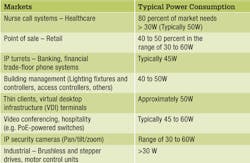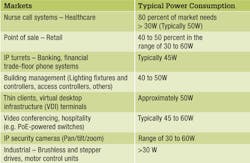IEEE studying four-pair Power over Ethernet
From the May, 2013 Issue of Cabling Installation & Maintenance Magazine
Group examining the possibilities of providing more, and more-efficient, power per port.
by Patrick McLaughlin
The Institute of Electrical and Electronics Engineers (IEEE; www.ieee.org) recently announced it has formed a study group to consider a formal project to standardize four-pair Power over Ethernet (PoE). The Four-Pair Power over Ethernet Study Group will investigate and consider a four-pair solution's capability to enhance energy efficiency and provide greater than 25.5 Watts of power.
It is possible but not definite that the efforts of this study group ultimately will result in a PoE standard. Chad Jones, who chairs the study group, and Wael Diab, vice chair of the IEEE 802.3 Ethernet Working Group, each commented about the possibilities of such efforts as well as the reality that every one of those possibilities is tentative.
When the IEEE announced the study group's formation, Jones said, "PoE has become the dominant powering method in many Ethernet-based products—access points and IP phones, for example—demonstrating that customers will migrate toward convenience. Enabling applications beyond 25.5 Watts will extend this convenience to other products. An additional benefit is the reduction of power lost in the delivery channel by at least half. This benefit can be extended to existing powered products by moving from a two-pair powering system to a new four-pair powering system."
Also at that time, Diab added, "A four-pair PoE standard would result in increased power and increased efficiency for Power over Ethernet applications. The group's main purpose is to continue the success of the PoE family of standards."
Efficiency gains
In an interview with Cabling Installation & Maintenance, Diab offered additional insight. He recalled, "The case that was made in front of the [802.3 Ethernet] Working Group was simple: A more-efficient way to deliver power. We know of applications that exist for higher power. But we're not going to undo anything that was done in the 802.3af or 802.3at standards. We're going to add to it."
On the suggestion that the eventual four-pair PoE technology might be compatible with 10-Gbit/sec data networks, Diab noted, "We look at PoE as being adjacent to the PHY standard; it is designed to work over certain channels, with certain PHYs. There is no concept of ‘10G PoE.' AT specifically was not qualified to work with 10GBase-T." While neither Diab nor Jones would say that an objective of the study group is to lay the groundwork for an eventual version of PoE that works with 10GBase-T, it was clear to this author that capability is one of the possibilities the group will study.
Some insight into the motivations behind the formation of this group exists in the call for interest that was presented to the IEEE 802.3 Working Group. One portion of that presentation provided detail on the target markets for four-pair PoE technology. The table that appears in this article is taken from that presentation.
No blanket statement would be made about the notion that someday, if indeed an IEEE four-pair PoE specification is finalized, some existing 802.3af- or 802.3at-compatible powered devices currently deployed in the field could convert to four-pair powering.
Meeting the criteria
Four-pair PoE is subject to the same five criteria that other IEEE initiatives must address—1) broad market potential, 2) compatibility, 3) distinct identity, 4) technical feasibility, 5) economic feasibility. If the study group sufficiently demonstrates that the proposed technology meets all five, it may move ahead into a more-formal development process.
Among the statements made in the call for interest about the current need for a four-pair PoE specification is that several proprietary solutions already exist in the market, making the need for standardization imminent. One proprietary solution is Cisco's Universal Power over Ethernet (UPOE) system. When UPOE was launched in 2011, Cisco explained it "provides the capability to source up to 60W of power by using all four pairs of standard Ethernet cabling (Cat 5e or better)."
Early adopters are deploying four-pair device powering, and have been for close to two years. Now the race to standardize this technology is on. ::
Patrick McLaughlin is our chief editor.
View Archived CIM Issues
About the Author
Patrick McLaughlin
Chief Editor
Patrick McLaughlin, chief editor of Cabling Installation & Maintenance, has covered the cabling industry for more than 20 years. He has authored hundreds of articles on technical and business topics related to the specification, design, installation, and management of information communications technology systems. McLaughlin has presented at live in-person and online events, and he has spearheaded cablinginstall.com's webcast seminar programs for 15 years.


